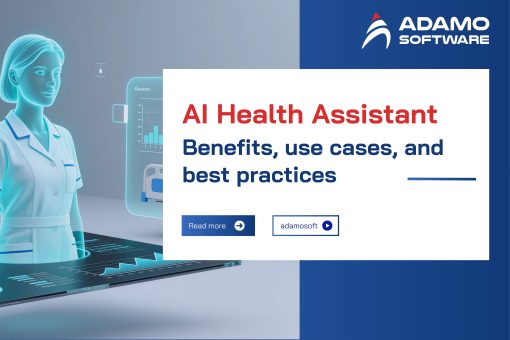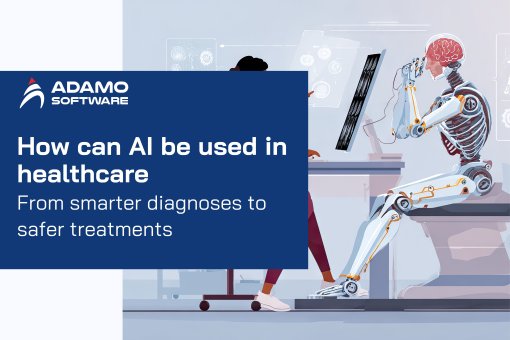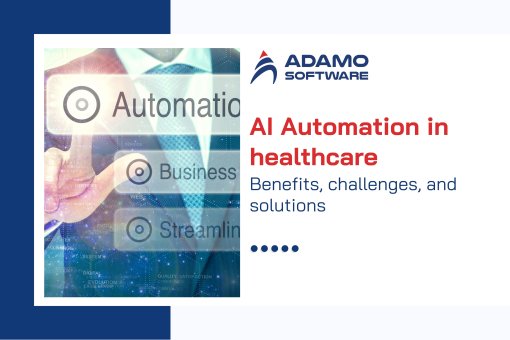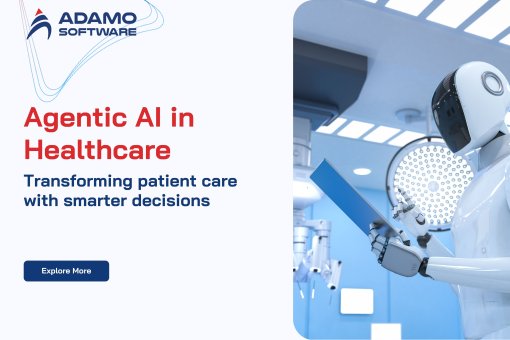Medical Billing Software: Types, features and development guide
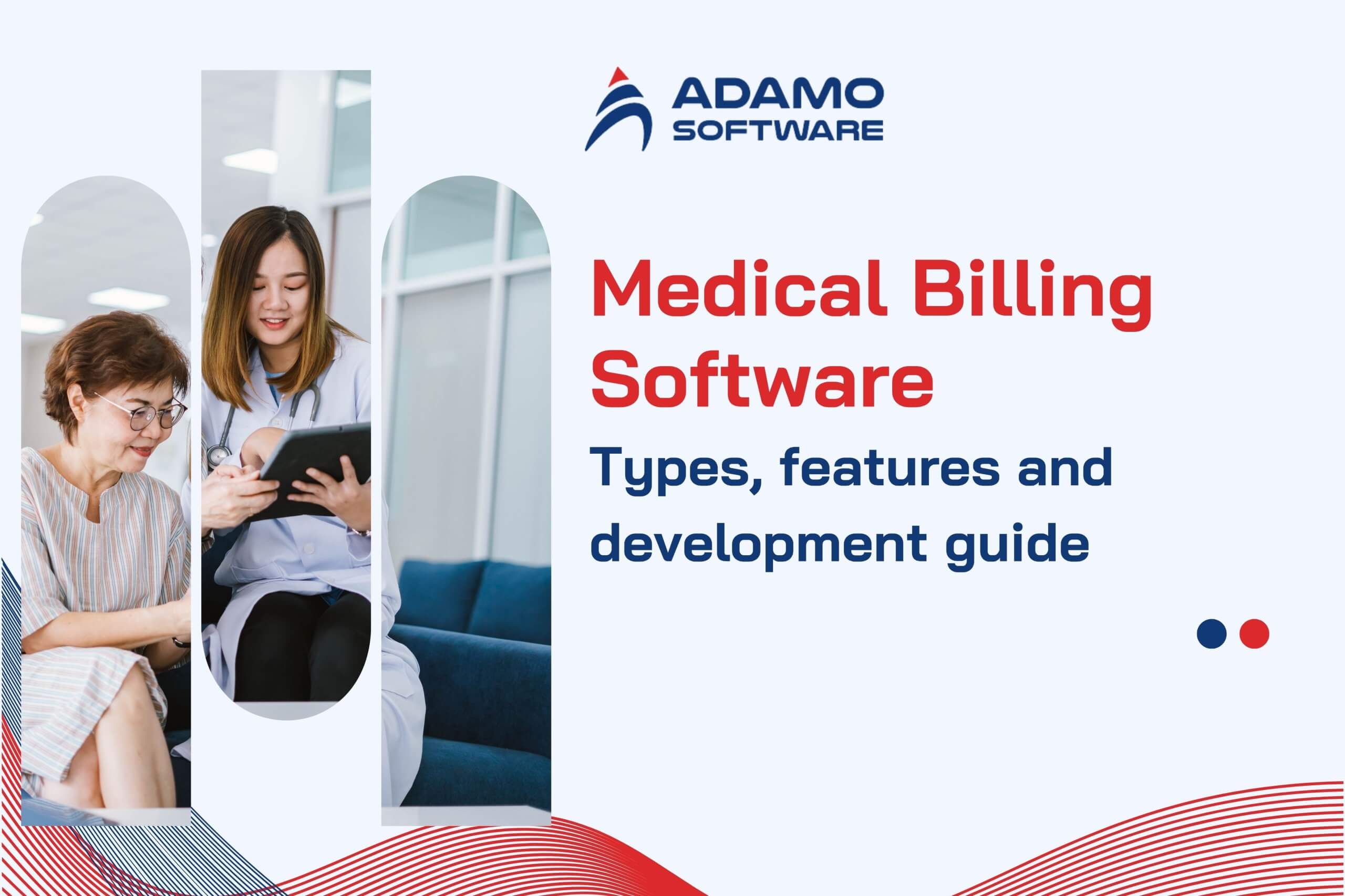
Medical billing software speeds up processes, lowers mistakes, and maximizes financial cash flow. It enhances billing operations.
The medical billing software enables healthcare organizations to handle their patient billing process, insurance claims, and payment collection. It enhances billing operations. The medical billing software speeds up processes, lowers mistakes, and maximizes financial cash flow. Medical organizations use medical billing software to streamline their financial processes effectively.
Medical billing software exists in multiple types that address particular requirements. Insurance claim automation features are present as a medical billing system. Yet another system provides powerful analytical capabilities. A practice should select its software based on the operations’ size and the billing complexity.
We will investigate diverse medical billing software varieties combined with their various benefits and significant features needed for selection. This article provides guidelines about producing software development while offering experienced knowledge. The guideline instructs healthcare providers and developers about effective medical billing software development and usage techniques.
I. What is medical billing software?
Digital healthcare providers rely on medical billing software to accomplish their billing processes and manage insurance claims and payments. The software system executes multiple procedures. This enhances both speed and precision in billing operations. The medical billing software helps doctors, hospitals, and clinics minimize paperwork. This reduces errors in the hospital management operations.
The program enables healthcare providers to establish connections between insurance entities and their patient base. Such software enables medical institutions to process insurance claims and monitor payments with automated invoice generation. Submitting bills by hand takes too much staff time and introduces potential errors.
The medical billing software maintains compliance levels down to a scientific degree. The software implements all necessary healthcare requirements with current billing protocols. Handling medical billing procedures is crucial because wrong billing practices lead to incorrect claims and financial reimbursement problems.
Basic features of medical billing software include electronic claim processing and tracking payments besides automatic billing notifications. The more sophisticated billing systems include reporting capabilities and analytic functionality. These capabilities assist healthcare providers in understanding their financial status. They also help to develop better financial controls.
This kind of Hospital Management System helps health facilities process invoices faster through simplified operations for maximum efficiency. Healthcare providers benefit from this software because it lowers mistakes and speeds up operations. It increases their financial cash flow. Every practice of every size depends on medical billing software for successful financial operation.
II. Fundamental types of medical billing apps
There exist multiple kinds of medical billing software that target different client requirements. Healthcare providers must select software programs that match their practice dimensions, with billing intricacy and financial constraints. Multiple varieties of medical billing software apps exist that serve healthcare establishments differently.
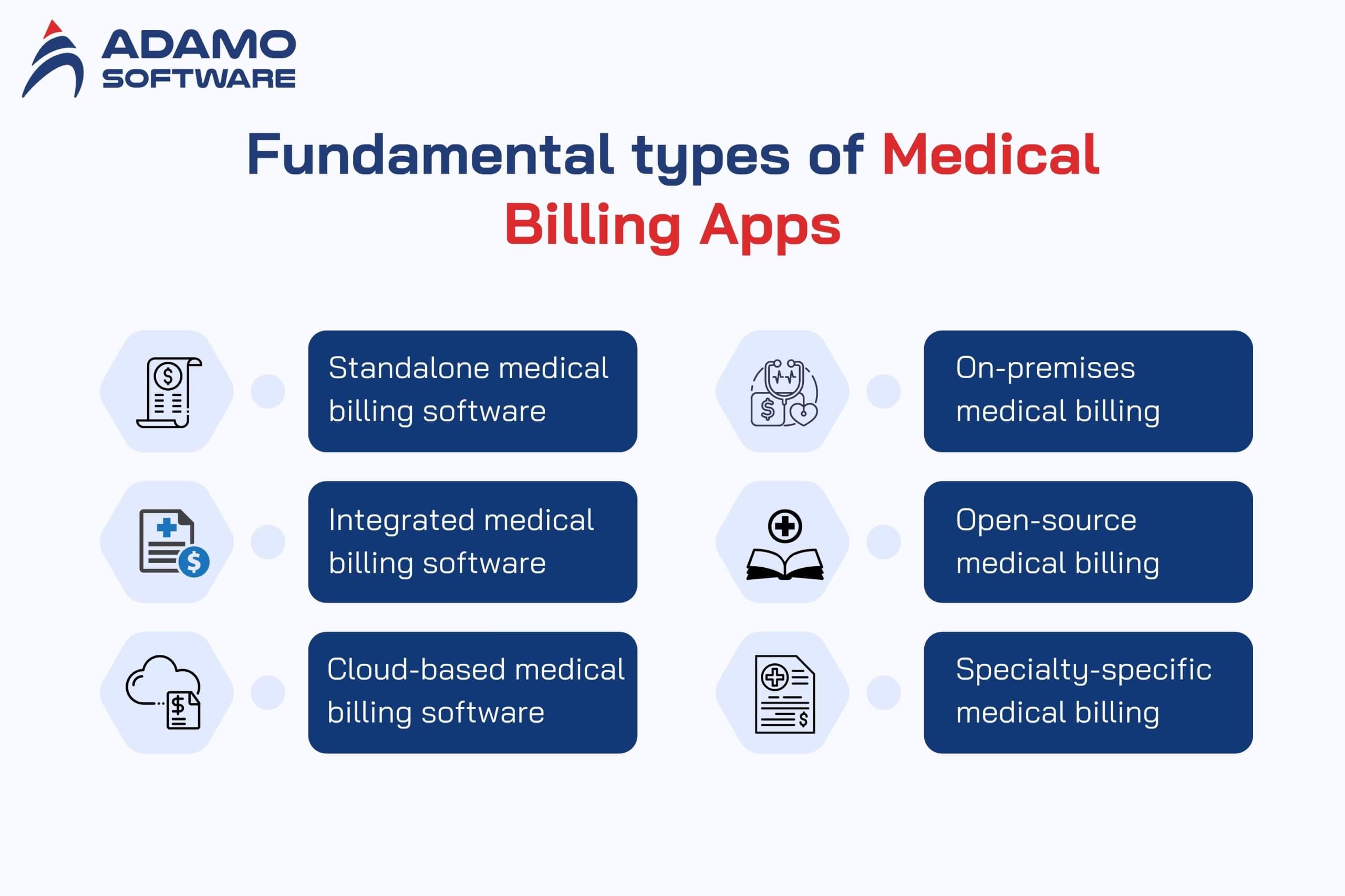
1. Standalone Medical Billing Software
Medical billing software dedicated to financial management handles solely billing operations. Healthcare providers use this software to control insurance claim submissions and monitor invoices while executing payments. Medical software of this kind serves the needs of separate clinics and independent practitioners who avoid complete electronic health record (EHR) system integration. The billing system offers efficient pricing and basic operation.
2. Integrated Medical Billing Software
A medical billing software system merges functionality with electronic health records (EHR) and practice management systems. Medical facilities can handle their patient data with billing operations by a unified platform. Medical organizations experience higher efficiency. This platform unites doctors and billing workers access to complete patient record data. The majority of healthcare facilities that operate large hospitals and multi-specialty clinics adopt integrated solutions.
3. Cloud-Based Medical Billing Software
Cloud-based medical billing programs enable users to save their data on servers outside the local computer system. A software system provides access for users who need only an internet connection to work on their devices. Through this software, users obtain automatic updates and better security, and remote accessibility features for their billing teams. Cloud-based solutions function best for providers who need flexible systems with instant access to data.
4. On-Premises Medical Billing Software
High-end medical billing software exists in the on-premises category. Since users are required to install it on their local servers and computers. The system gives users total control over their database security measures. Healthcare organizations with large hospitals having stringent data privacy guidelines, choose on-premises solution deployment. The solution demands a significant initial capital outlay in addition to continuing support expenses.
5. Open-Source Medical Billing Software
Open-source medical billing software allows users to modify software components at no charge. Healthcare providers, together with developers, possess the capability to adjust the software to fit the required specifications. This software provides affordable solutions to medical practices and startups. Technical skill is needed when handling the setup and maintenance of open-source solutions.
6. Specialty-Specific Medical Billing Software
The market offers medical billing solutions targeted for dental practices along with dermatology and cardiology healthcare systems. The billing software provides specialized features that fulfill the specific billing conditions of medical specialties. Medical billing software with dental functions includes orthodontic procedure codes and also cardiology software containing cardiovascular codes.
A healthcare provider must evaluate their needs to select the appropriate medical billing software type. Medical practices utilizing standalone software solutions should prioritize standalone solutions. They suit their small practice, while large healthcare institutions benefit from integrated systems. Cloud-based setups give users flexibility.
However, on-premises deployment allows users to complete system control. Operators can save money with open-source software. However, specialty-specific billing applications deliver precise coding help for various medical practitioners. All versions of medical billing software contribute to higher billing speed, error reduction, and better financial management.
III. An investigation into the top advantages of medical billing software exists
Healthcare providers can use medical billing software to enhance their billing procedures through automation. This decreases mistakes while improving financial control systems. The software system performs repetitive tasks to speed up billing procedures while working more efficiently. The main advantages of medical billing software implementation include these points.
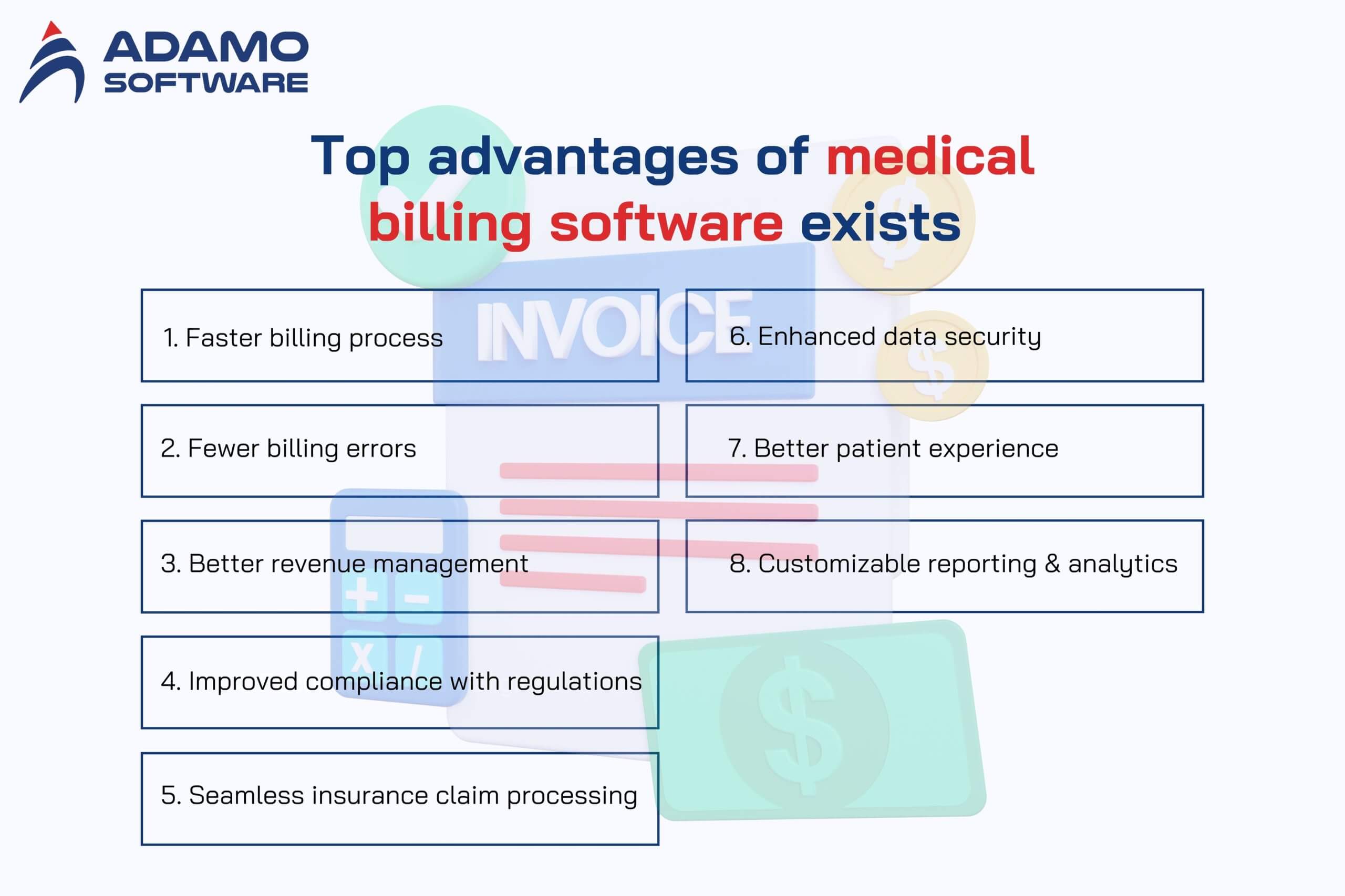
1. Faster Billing Process
Healthcare practices gain three major benefits from medical billing software because it handles the automation of invoices and claims filings with payment management. The software cuts down on human intervention. This enhances billing speed throughout the whole process. The faster handling of claims by clinics and hospitals through the software system helps generate immediate cash flow benefits that improve their financial stability.
2. Fewer Billing Errors
The manual billing system produces human errors through inaccurate patient data and improper selection of codes, with missing required documentation. Medical billing software establishes automated checks and validation features. This lowers the chances of billing mistakes. Claim denials from insurance companies become less frequent, while the approval rate increases when medical practices use this software.
3. Better Revenue Management
Healthcare providers utilize medical billing software to monitor payments while tracking claims awaiting processing and unfulfilled balances directly in real time. The software system helps medical providers better manage their revenue cycle activities. The software combines automated invoice notifications with payment reminders that help speed up collection times.
4. Improved Compliance with Regulations
The medical billing system includes built-in features that obey healthcare legislation such as HIPAA and ICD standards for coding purposes. Billing system compliance with legal standards becomes possible through the software. This minimizes the potential costs of non-compliance and regulatory penalties.
5. Seamless Insurance Claim Processing
The manual task of processing insurance claims takes up too much time and creates complications in the process. Medical billing software performs automated insurance claim processing through its functions. This verifies details and checks coding systems while making electronic submissions. The automatic claim submission process shortens delays to improve approval outcomes.
6. Enhanced Data Security
Protecting patient data with financial information within medical billing software relies on encryption, multi-factor authentication, and access management systems to safeguard confidentiality. Cloud-based solutions ensure the automatic backup of essential data to minimize vulnerability risks.
7. Better Patient Experience
The satisfaction of patients depends on their ability to understand their medical bills. Medical billing software generates transparent invoices and uses automated payment reminder systems while offering diverse payment methods for customers. The system enables patients to see their medical bills. Therefore, they can finish payments without any difficulties.
8. Customizable Reporting and Analytics
The reporting features within medical billing software assist healthcare providers in evaluating their financial operations. The software provides detailed financial reports about billing trends with denial statistics and uncollected money amounts. Correct financial decisions become possible because of the valuable information provided by these insights.
Implementing medical billing software brings numerous advantages to medical practices. It decreases mistakes while improving money flow. The software guarantees compliance. It accelerates claim processing and provides advanced security to healthcare data. Healthcare providers improve patient experiences through their billing operations using medical billing software.
IV. Nice-to-have medical billing software features to consider
The core features of medical billing software include claim processing and payment tracking capabilities. Greatly enhanced efficiency comes from implementing particular advanced features within billing programs. Multiple additional tools within the system improve security measures and user precision while enhancing system usability. Several additional features below should be checked when selecting medical billing software.
1. Automated Coding Assistance
Medical billing programs with built-in coding support enable healthcare organizations to select proper medical codes. The software application automatically suggests relevant ICD-10 CPT and HCPCS coding for users. Simultaneously, the system decreases error frequency, and claims succeed at higher rates. Time efficiency for billing staffers becomes possible with this software.
2. AI-Powered Claim Scrubbing
Before insurance claim submissions, the system performs claim scrubbing to check for errors. The combination of medical billing software with up-to-date claim scrubbing technologies detects errors and omits data immediately. Timely reimbursement occurs due to decreased claim rejection rates.
3. Multi-Location Support
Hospitals having extensive facilities with several locations as components form a typical operational structure in modern healthcare settings. Medical billing software that offers multi-location support enables unified billing operations over different medical locations. Medical billing software functions to combine billing statistics into one database while keeping financial documentation uniform.
4. Patient Payment Portal
Through their patient payment portal, healthcare consumers can easily access their medical bills for online payment processes. The payment feature in medical billing software guarantees safe electronic payment methods through credit cards, bank transfers, and digital wallets. Patient satisfaction increases while delayed payments decrease.
5. Automated Payment Reminders
Medical cash flow receives negative effects from unpaid payments that are past due. The patient payment portal in medical billing software automatically communicates important payment-related information to patients. This software platform distributes notifications through three different communication channels. These channels include email, SMS, and phone system messages. Through this functionality, medical providers can obtain their payment funds promptly.
6. Advanced Reporting and Analytics
Medical billing programs, including analytical tools enable you to track business financial data. The system produces three reports demonstrating claim denial statistics and financial trend information with patients’ unpaid balances. The produced insights enable healthcare providers to make improved financial choices that advance revenue operations.
7. Integration with EHR and Practice Management Systems
Healthcare providers benefit from data sharing through Electronic Health Records integration with practice management systems. The built-in feature of patient records and billing access from a single platform exists in medical billing software. Implementing this feature decreases the paperwork burden. This brings about better efficiency.
8. Customizable Billing Rules
Healthcare providers maintain diverse needs when it comes to their billing processes. Medical billing software lets users define payment condition regulations using customizable billing rules for insurance policies and payment discounts. Flexibility increases throughout the software because it adjusts to various medical practice requirements.
9. Multi-Currency and Multi-Language Support
Medical service providers in international locations require access to multiple currencies and several languages for their operations. The features of medical billing software enable users to create bills in different currencies and languages while supporting business operations. The system benefits medical tourism operations with telemedicine functions.
10. Blockchain for Enhanced Security
Medical billing operations require absolute security to be a fundamental necessity. Modern medical billing software solutions implement blockchain technology to establish data protection for patients. Blockchain maintains secure financial transactions through its built-in protection features, stops fraudulent activity, and operates as an open window to billing records.
Additional medical billing software features enable practitioners to boost operational efficiency while improving safety measures and enhancing patient interactions. Medical billing applications that combine algorithms with AI processing capabilities with multi-branch deployment capabilities help reduce error rates while increasing processing speed. Patients who use the payment portal with an automated reminder system benefit from faster payments. The software becomes better adaptable through its capability to integrate with EHR systems and its advanced reporting features and lets users set billing rules. Additional features in medical billing software enable healthcare providers to reach maximum billing operation efficiency while generating higher revenue.
V. How to build medical billing software in 6 steps
The construction of medical billing software needs proper planning alongside healthcare industry expertise and specialized technical skills. Medical billing software development creates a system that enhances provider management of billing operations. It claims processing functions and financial management processes. A patient must follow these six critical procedures to construct medical billing software.
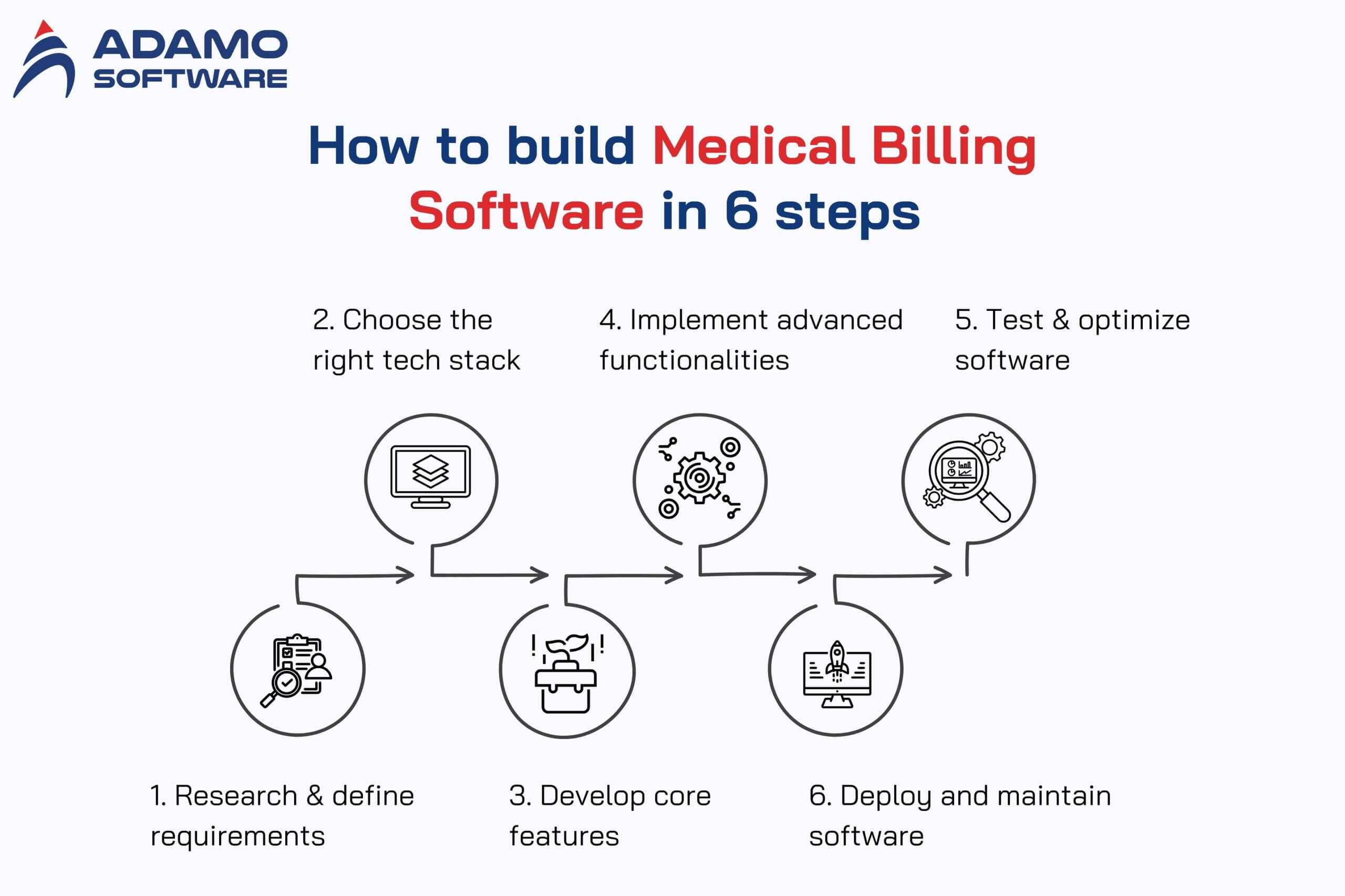
Step 1: Research and Define Requirements
Hospital medical billing software development begins with analyzing healthcare provider needs. Investigate the existing billing practices operated by hospitals and clinics with private medical practices. Review which difficulties medical organizations encounter by analyzing claim rejections, late payment timings, and non-compliance issues.
Key requirements to consider:
- The system includes automated billing processes, which decrease human labor requirements.
- The system will enable faster processing of insurance claims, which leads to quicker reimbursements.
- HIPAA compliance functions alongside the system to safeguard the protection of medical data.
- Integration with EHR systems for seamless data exchange
- User-friendly interface for easy navigation
The requirement list must be precise to make sure the software fulfills both industrial standards and user requirements.
Step 2: Choose the right technology stack
Medical billing software development requires appropriate technologies that guarantee software reliability and scalability.
Common technologies used:
- Frontend: React, Angular, or Vue.js for an intuitive user interface
- Backend: Node.js, Python (Django), or Java (Spring Boot) for server-side logic
- Medical billing software makes use of MySQL PostgreSQL and MongoDB databases for patient and cost information storage.
- The selected cloud services include AWS, Google Cloud, and Azure, which provide secure cloud-based storage solutions for medical organizations.
A suitable technology stack requires capabilities for expansion and complete security measures alongside immediate data processing.
Step 3: Develop core features
Creating essential functions that enable medical billing software to operate is the following development step.
Key features include:
- The system maintains patient information along with details about insurance along with medical background records during registration.
- The software system generates automatic bills, which it distributes to patients through billing and invoicing features.
- Through electronic submission and tracking, the system handles insurance claim processes.
- Payment Processing – Supports multiple payment methods like credit cards and bank transfers.
- Compliance and Security – Comply with all the healthcare regulations.
Medical billing software contains core features for financial transaction streamlining processes.
Step 4: Implement Advanced Functionalities
The current medical billing software can become more effective by implementing special functionality.
Nice-to-have features include:
- The system uses artificial intelligence to analyze claims before they reach the submission stage to detect billing mistakes.
- Payment reminder tools within the system function automatically to lower late payments.
- The software includes custom analysis tools that provide medical offices with detailed financial data about their revenue patterns.
- Multi-currency and multi-language support for international users
These supplemental capabilities provide both operational improvements and better user satisfaction.
Step 5: Test and optimize the software
The testing and optimization phase of the software development process should be executed here.
The medical billing software requires extensive testing to proceed towards its market launch.
Important testing processes:
- Unit testing provides a system to uncover programming issues in standalone functionalities.
- Integration testing – Ensures the interaction between modules is smooth.
- Security testing – Protects patient and financial data from cyber threats.
- To verify software compliance with user expectations, functional testing under User Acceptance Testing (UAT) occurs.
- Through testing, software problems will be detected and create conditions for smooth operations.
The deployment phase of software development includes maintenance activities that begin following system release.
Step 6: Deploy and maintain the software
The software becomes deployable after testing is completed. Secure hosting should be selected while establishing scheduled maintenance protocols.
Key post-launch activities:
- Checking software performance will enable speed monitoring and reliability evaluation.
- The institution should educate healthcare workers to master system operation.
- The development team distributes bug fixes through updates to solve issues and expands the program’s functionality.
- The organization must provide its customers with technical help services for problem rectification and support for assistance tasks.
The software stays protected from threats through regular maintenance. This makes it operate more efficiently while maintaining current standards.
Research expertise, technical knowledge, and detailed planning are required to construct medical billing software. A powerful billing system emerges from following the six-step development process. Medical billing applications help healthcare organizations operate more efficiently. They can reduce their errors while assisting them in better managing their financial output.
VI. Contact with experts from Adamo Software for medical billing software development
Reaching out to experts at Adamo Software provides organizations with the opportunity to build medical billing software that meets their exact requirements. Adamo Software has developed extensive healthcare experience in building user-friendly, secure billing systems with high efficiency. Our team provides project leadership to lead you through software development while confirming regulatory compliance and system compatibility.
Your medical billing software development process will benefit from Adamo Software’s healthcare solutions expertise. We will help create a system that enhances billing efficiency and error reduction and supports better revenue cycle management. Medical billing complications are well understood. We can create perfect solutions tailored to your practice or organization.
FAQs
1. How long does it take to produce software for medical billing operations?
The duration required to develop medical billing software depends on the number of features and complexity. A fundamental medical billing and invoicing system requires between three and six months for development. The development of advanced medical billing software takes between six months to one year or more. It features AI automation, EHR system integration, and compliance management. The duration of creating medical billing software depends on multiple variables. It includes team strength and technological selection with regulatory guidelines.
2. What are the key challenges in building medical billing software?
Several obstacles appear during the development of medical billing software.
- The product requires full compliance with HIPAA along with ICD-10 healthcare codes and other applicable patient data protection regulations. This is to maintain security and claim precision.
- The billing process depends heavily on complete connectivity between EHR and insurance provider platforms.
- The medical billing software must reduce errors to the lowest levels because these errors cause payment rejections and delayed reimbursement. Automated claim processing systems endorsed by artificial intelligence enable better claim scrubbing and validation.
- Data protection with security remains crucial because billing software maintains sensitive information. Therefore, encryption and multi-factor authentication systems are required.
3. How much does it cost to develop medical billing software?
Medical billing software development expenses fluctuate depending on the number of included features, the geographic location of the development team, and software complexity measures.
- A medical billing software system equipped with basic essential functions typically arrives at a price range between $30,000 and $70,000.
- Medical software at the middle level extends from $70,000 to $150,000 when it includes claim handling and electronic health record integration with reporting elements.
- The upper-tier medical billing system comprising AI automation together with analytics and expanded location functionality exceeds $200,000 in costs.
Creating medical billing software requires organizations to follow proper planning procedures. They must ensure regulatory compliance and select the appropriate technology stack. The involvement of seasoned developers creates a protected, competent, and extendable billing system.
4. What limitations exist with cloud-based medical billing software?
Cloud medical billing systems can face internet-dependency, meaning downtime or slow connections can interrupt billing tasks. They also involve ongoing subscription costs, may pose data privacy and security risks, and sometimes struggle with integration into older EHR or practice-management systems. Clinics may also encounter workflow disruptions during transition and vendor lock-in risks if the provider experiences outages or changes services.







